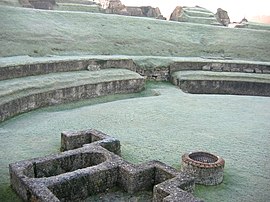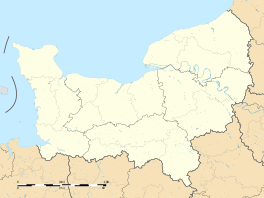Lillebonne
| Lillebonne | ||
|---|---|---|

Roman theater
|
||
|
||
| Coordinates: 49°31′08″N 0°32′03″E / 49.5189°N 0.5343°ECoordinates: 49°31′08″N 0°32′03″E / 49.5189°N 0.5343°E | ||
| Country | France | |
| Region | Normandy | |
| Department | Seine-Maritime | |
| Arrondissement | Le Havre | |
| Canton | Lillebonne | |
| Intercommunality | Caux-Vallée de Seine | |
| Government | ||
| • Mayor (2008–2013) | Nicolas Beaussart | |
| Area1 | 14.66 km2 (5.66 sq mi) | |
| Population (2006)2 | 9,866 | |
| • Density | 670/km2 (1,700/sq mi) | |
| Time zone | CET (UTC+1) | |
| • Summer (DST) | CEST (UTC+2) | |
| INSEE/Postal code | 76384 / 76170 | |
| Elevation | 0–1,338 m (0–4,390 ft) (avg. 6 m or 20 ft) |
|
|
1 French Land Register data, which excludes lakes, ponds, glaciers > 1 km² (0.386 sq mi or 247 acres) and river estuaries. 2Population without double counting: residents of multiple communes (e.g., students and military personnel) only counted once. |
||
1 French Land Register data, which excludes lakes, ponds, glaciers > 1 km² (0.386 sq mi or 247 acres) and river estuaries.
Lillebonne is a commune in the Seine-Maritime department in the Haute-Normandie region in northern France. It lies 3.5 miles (5.6 km) miles north of the Seine and 24 miles (39 km) east of Le Havre.
Before the Roman conquest of Gaul Juliobona was the capital of the Caletes, or inhabitants of the Pays de Caux. It was destroyed by Julius Caesar and afterwards rebuilt by Augustus. Before it was again ruined by the barbarian invasions, it had become an important centre whence Roman roads branched out in all directions. It was an administrative, military and commercial city located close to the Seine. This made it a great transportation route between Brittany (current England) and the remainder of the Roman Empire. It was also a crossroads of communication in order to bring Roman ways to Harfleur, Étretat, Dieppe, Évreux and Rouen.
The remains of Roman baths and of a theater capable of holding 3,000 persons have been brought to light. Many Roman and Gallic relics, notably a bronze statue of Apollo (exposed in Le Louvre), and two fine mosaics exposed to the museum at Rouen, have been found. In the Middle Ages the fortifications of the town were constructed out of materials supplied by the Roman theater. The town recovered some of its old importance under William the Conqueror.
...
Wikipedia



